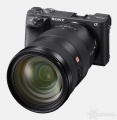In tempi di crisi le collaborazioni tra grandi produttori diventano sempre più comuni.
Dopo il sodalizio Olympus-Sony che porterà all'introduzione del sistema di stabilizzazione a 5 assi di Olympus sulle mirrorless Sony, arriva dalla collaborazione tra Panasonic e Fujifilm il primo sensore CMOS organico.
A differenza dei sensori usati oggi che utilizzano un fotodiodo al silicio per catturare la luce, questo nuovo sensore impiega invece uno strato di conversione fotoelettrica organico ad alto coefficiente di assorbimento, riducendo cosi lo spessore fotosensibile a 0,5 micron.
Nella pratica reale, la tecnologia di questa innovazione Panasonic-Fujifilm consente di aumentare il range dinamico del sensore, di migliorarne la sensibilità e di poter catturare raggi di luce con un angolo incidente di 60° a tutto vantaggio di ottiche più compatte ed idealmente indirizzate al segmento di mercato delle macchine mirrorless.
Di seguito, la press release ufficiale congiunta Panasonic-Fujifilm.
Fujifilm and Panasonic jointly develop an organic CMOS image sensor technology using organic photoelectric conversion layer
Offers Industry's highest* dynamic range and sensitivity for vivid and texture-rich images
FUJIFILM Corporation (President: Shigehiro Nakajima) and Panasonic Corporation (President: Kazuhiro Tsuga) have developed organic CMOS image sensor technology that uses an organic photoelectric conversion layer with a photoelectric conversion property at the light receiving section of an image sensor to achieve performance beyond that of conventional image sensors**. Applying this technology to the image sensors of digital cameras and other imaging devices expands its dynamic range*** and enhances sensitivity*4 further to prevent highlight clipping in bright scenes and capture a dark subject with vivid colors and rich textures.
The industry has put into continuous efforts to explore image sensor technologies for increasing their number of pixels. This has dramatically improved sensor resolutions, but, in order to further boost image quality, it is necessary to expand the dynamic range, enhance sensitivity and prevent cross-talk or color mixing between pixels. Panasonic took advantage of its semiconductor device technology to boost image quality for its high-performance image sensors. Fujifilm, on the other hand, has developed highly-reliable organic photoelectric conversion layer with high absorption coefficient to be used on a sensor's light receiving section instead of silicon photodiode*5 in its effort to build a new image sensor technology.
In the latest collaboration, Fujifilm and Panasonic have combined Fujifilm's organic photoelectric conversion layer technology with Panasonic's semiconductor device technology to jointly develop an organic CMOS image sensor that outperforms conventional image sensors. The new organic CMOS image sensor offers the industry's highest dynamic range of 88dB, advanced sensitivity 1.2 times more sensitive than conventional sensors** and broader range of incident angle*6 to enable the production of more sensitive and compact cameras with better image quality.
The two companies will promote the application of this organic CMOS image sensor technology to a wide range of products including security cameras, in-vehicle cameras, mobile device and digital cameras.
Fujifilm and Panasonic will present the research results at the 2013 Symposium on VLSI Technology (VLSI2013) to be held in Kyoto on June 11, and the 2013 International Image Sensor Workshop to be held in Utah, U.S.A. on June 15.
- * Performance of the light receiving section of image sensors, as of June 11, 2013 according to Panasonic data.
- ** Estimation from Panasonic image sensors
- *** Range of light that can be recorded (ratio between the brightest and darkest areas recorded)
- *4 The sensitivity of image sensors refers to the conversion ratio of light into electric signals. The greater the sensitivity is, the clearer you can capture low-light scenes.
- *5 A type of photo detector that senses incident light, installed for each image sensor pixel to convert light into electric signals
- *6 Range of incident light angles for efficient conversion into electric signals







